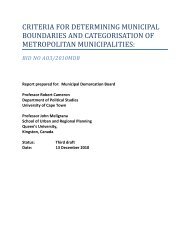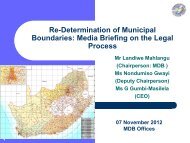Mr LJ Mahlangu - Municipal Demarcation Board
Mr LJ Mahlangu - Municipal Demarcation Board
Mr LJ Mahlangu - Municipal Demarcation Board
Create successful ePaper yourself
Turn your PDF publications into a flip-book with our unique Google optimized e-Paper software.
An item of property, plant and equipment is derecognised<br />
when the asset is disposed or when there<br />
are no economic benefits or service potential from<br />
the use of the asset.<br />
The gain or loss arising from derecognition of an<br />
item of property, plant and equipment is included<br />
in surplus or deficit when the item is derecognised.<br />
The gain or loss arising from the derecognition of an<br />
items of property, plant and equipment is determined<br />
as the difference between the net disposal proceeds,<br />
if any, and the carrying amount of the item.<br />
H. PRIOR YEAR ERRORS<br />
The <strong>Board</strong> shall correct material prior year errors<br />
retrospectively in the first set of financial statements<br />
authorised for issue after their discovery by:<br />
i) Restating the comparative amounts for the<br />
prior year(s) presented in which the error occurred;<br />
or<br />
ii) If the error occurred before the earliest prior<br />
year presented, restating the opening balances<br />
of assets, liabilities and accumulated<br />
surplus for the prior year presented.<br />
I. INVENTORIES<br />
Inventories are assets held in the form of materials<br />
or supplies to be consumed in the production process<br />
or in the rendering of services. Inventories are<br />
recognised as an asset when it is probable that<br />
future economic benefits or service potential associated<br />
with the item will flow to the <strong>Board</strong>, and<br />
when the cost of the inventories can be measured<br />
reliably. Where inventory is acquired at no cost, or<br />
for nominal consideration, their cost shall be their<br />
fair value as at the date of acquisition.<br />
The cost of inventories shall comprise all costs of<br />
purchase, costs of conversion and other costs incurred<br />
in bringing the inventories to their present<br />
location and condition. Inventories are valued at<br />
the lower of cost and current replacement cost<br />
where it is held for distribution at no charge or<br />
nominal charge, or consumption in the production<br />
55 MUNICIPAL DEMARCATION BOARD - Annual Report 2012<br />
process of goods to be distributed at no charge<br />
or for a nominal charge. The cost of inventories<br />
shall be assigned by using weighted average cost<br />
formula.<br />
J. INTANGIBLE ASSETS<br />
An asset is identified as an intangible asset when it:<br />
(i) is capable of being separated or divided from<br />
an entity and sold, transferred, licensed, rented<br />
or exchanged, either individually or together<br />
with a related contract, assets or liability; or<br />
(ii) arises from contractual rights or other legal<br />
rights, regardless whether those rights are<br />
transferable or separate from the Institution or<br />
from other rights and obligation.<br />
Initial Recognition<br />
Intangible assets are recognised when it is probable<br />
that expected future economic benefits or<br />
service potential attributable to the asset will flow<br />
to the <strong>Board</strong> and when the cost or fair value of the<br />
asset can be measured reliably.<br />
Subsequent Measurement<br />
Intangible assets are initially recognised as assets<br />
on acquisition date and are initially recorded at<br />
cost. Where an asset is acquired at no cost, or for<br />
a nominal cost, its cost is measured at it fair value<br />
as at the date of acquisition.<br />
Amortisation<br />
Intangible assets are amortised on a straight-line<br />
basis over their useful lives. After initial recognition,<br />
intangible assets are carried at cost less<br />
accumulated amortisation and accumulated impairment<br />
losses. The amortisation period, amortisation<br />
method and residual value is reviewed at<br />
each financial year end. The residual value of intangible<br />
assets is assumed to be zero.<br />
Computer software is stated at amortised cost and<br />
is amortised on a straight-line method over the estimated<br />
useful life of three (3) years.




